National Pet Dental Health Month: How to Brush Your Pet’s Teeth
Posted: 11/06/2023 | BY: Erin Cain | Categories: Uncategorized
February is National Pet Dental Health Month, and it’s the perfect time to start brushing your furry friend’s teeth! Many pet parents don’t realize how important it is to keep their furkid’s teeth clean. Not only does it help keep their breath smelling fresh, but it also helps prevent gum disease, tooth decay, and other oral health problems. Let’s examine why dental issues are prevalent in pets, as well as how to brush your dog or cat’s teeth properly. We’ll also explore some helpful tips to make the oral cleaning process easier for both you and your pet.
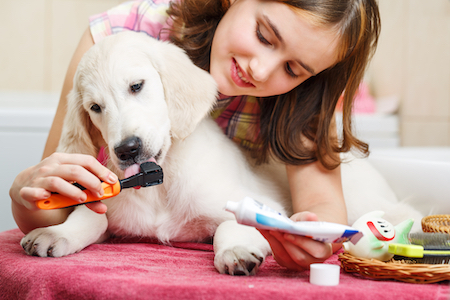
Why is it important to clean your pet’s teeth?
Brushing your pet’s teeth is the most effective way of reducing dental plaque, tartar buildup, yellowing, and maintaining long-term oral health. Like humans, oral brushing will not only prevent tartar formation but also promotes healthy gums, which are essential for preventing halitosis (bad breath). Weekly brushing should occur whenever possible and more frequently for pets who already have some form of dental disease.
Periodontal disease is the most common dental disease in pets and one that many veterinarians call attention to each year. It occurs when bacteria in the mouth lead to plaque buildup. The plaque then calcifies into tartar which hardens. Once it is present below the gum line, it can lead to gum disease, gingivitis, root infection, disease, and ultimately, advanced periodontal disease. By the age of 3, nearly 80% of dogs and cats already have dental issues and show signs of periodontal disease. Your pet’s dental health care needs to be a priority not only to keep them healthy and avoid costly vet bills but to help them live longer, healthier lives.
A veterinarian should examine your cat or dog’s teeth annually to find and diagnose any dental disease as early as possible. If your pet exhibits any of the following signs and symptoms of oral health issues, it may be time for a visit to the vet for a dental check-up:
- bad breath with a strong odor
- pain, bleeding, or swelling in, around, or from the mouth
- swollen gums
- red gums
- unusual or rapid weight loss
- refusal to eat or drink, inability to eat or drink, or difficulty chewing
- abnormal drooling, chewing or dropping food while eating
- loose or broken tooth
- discolored or tartar-covered teeth
- retained baby teeth or extra teeth
- irritability or changes in personality and behavior
Proper dental cleaning and care now will prevent your pet from various illnesses in the future, such as:
- preventing tooth loss and oral pain
- preventing worsening dental diseases
- preventing damage to internal organs
Some pet parents don’t realize that proper oral health care for their pet now means preventing dental disease and severe illnesses later on. Suppose bacteria from your pet’s mouth enter the bloodstream and spread throughout your pup’s body. In that case, damage can occur to internal organs such as the kidneys or liver, making her quite sick and shortening their lives.
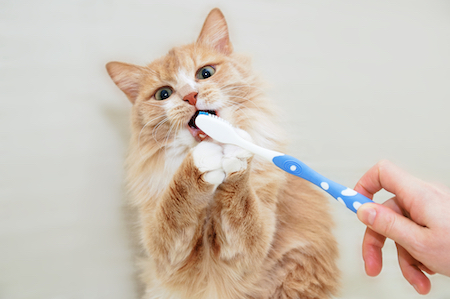
What supplies do you need for cleaning your pet’s teeth?
Many online and local pet stores and veterinarian offices offer brushing supplies for reasonable prices. Often, they have “starter kits” available, so you have everything you need in one package for daily brushing to remove plaque. Here are the items to have on hand before brushing your pet’s teeth.
Pet-friendly toothpaste
The first step in preparing to clean your pet’s teeth is to have pet-appropriate toothpaste on hand specially designed for dogs or cats. Never use human toothpaste on a pet because the fluoride, artificial sweeteners like xylitol detergents, can be toxic if they swallow it, especially dogs. Instead, find a pet toothpaste that has a tempting flavor, such as mint, beef, or chicken, that will make the experience more pleasant for your furkid. The paste ingredients are safe for dogs and cats to consume as they are meant to be swallowed and will not harm your furry friend.
There are also some homemade pet toothpaste recipes for the DIY pet parents who are more hands-on with their pet’s dental health. Whether you make your pet toothpaste or buy one of the many commercial pet toothpaste flavors, the most important thing is to prevent oral disease in your pet with regular dental care.
Pet-appropriate toothbrushes
Various toothbrush sizes and styles are available so you can find the right fit for your cat or dog. Some brushes are single head or double head. Baby toothbrushes with extra soft bristles, sponge toothbrushes, and specialty toothbrushes that fit on your finger are other viable brush options. Child-sized brushes and finger brushes are particularly helpful for accessing small spaces in the mouth with bristles soft enough not to cause oral pain.
It may be a matter of trial-and-error to find the toothbrush your furkid will accept, but don’t give up. There are many other options to find the best fit, and if you’re struggling with your dog or cat, you can also try using squares of gauze or a clean washcloth in place of a toothbrush.
Aside from regular veterinary examinations, the best way to help keep your cat or dog healthy is regularly clean them. That seemingly simple task can be surprisingly tricky. Many owners decide not to struggle with reluctant pets to clean their mouths. Here are some steps all pet parents can take to make tooth brushing a daily habit.
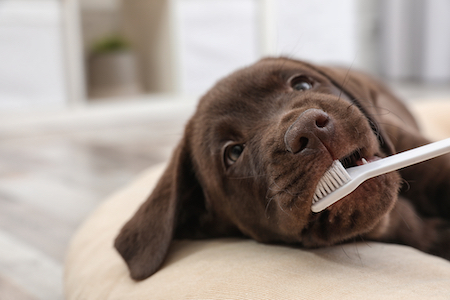
How to brush a dog’s teeth
Brushing your pup’s teeth efficiently relies on brushing correctly. Follow these steps to make toothbrushing an easier task for you and your dog and one that benefits your dog’s oral health:
- Practice touching your dog’s muzzle and mouth. Gently cup your dog’s chin, hold it, then give her a treat. Next, place one hand over your dog’s muzzle and the other underneath it. Again, hold for a few seconds, then treat your pup. Mimic what you will be doing through brushing by touching your dog’s face and mouth in various areas. Finally, cup the muzzle, lift the lips and use your fingers to examine the mouth. Placing a bit of peanut butter on your finger can make this practice more appealing to your dog.
- Let your dog sniff the tooth care supplies. When preparing for canine tooth brushing, it’s important to let her investigate and taste the item before you place it in her mouth. Being patient and allowing your dog to explore will help avoid any negative associations with toothbrushing in the future. Always use positive reinforcement during this step, as it will make brushing your dog’s teeth much easier in the future.
- Begin brushing. Start the tooth brushing session by placing a daub of tasty dog toothpaste flavors on the brush. Begin with the front teeth and move the paste carefully in a circular motion for about 10 seconds.
- Brush in stages. You shouldn’t expect to complete brushing your dog’s entire mouth the first time. Introduce the brushing process for about 10 seconds on their front teeth and then end the session. Continue these brief sessions over a week or so to get your dog used to toothbrushes.
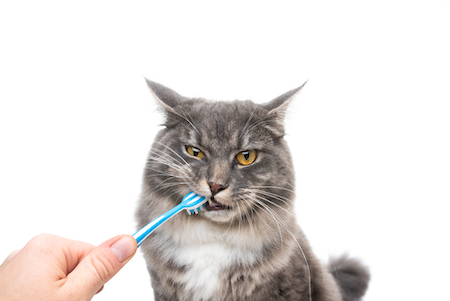
How to brush a cat’s teeth
Wondering how to clean your cat’s teeth, or even if you should clean them at all? Many cat parents dread the yowls, scratches, and hissing that may accompany brushing their feline’s teeth. However, it is in your cat’s best health interest to have regularly clean chompers. This February is an excellent time to focus on your kitty’s overall health. Here are some ways to clean your cat’s teeth without causing trauma and hard feelings.
- Introduce your cat to having her mouth opened. To get started, gently lift your cat’s lips during a quiet time in a comfortable location. Speak in a soft, positive voice while touching and rubbing the mouth. Cats take cues from how we communicate and act accordingly; if you sound stressed or nervous, they reflect that same feeling. Try dipping your finger in tuna water and running it gently along your cat’s gums to make your cat less resistant to your handling her mouth. Please note that you may need to do this over a few days before actual brushing occurs.
- Let your cat investigate the brushing supplies. Introduce your cat to the toothbrush and paste by letting her sniff it and paw at its surface. Then, give your cat a small amount of flavored paste to engage her interest. Once she is done sniffing, give your cat a small treat, so she associates the toothbrush and paste with a positive moment.
- Make your cat comfortable, then start brushing. Put your cat in your lap. Place some toothpaste on your finger, let your cat lick it, then rub the remainder along her gums. Use the paste on the brush, gently lift the cat’s lips, then gently rub the large front canine teeth. If your cat is fine with the process, slowly work on the other parts of the mouth, leaving the back molars for last.
If your cat is uncomfortable at any time, stop brushing, give her a cuddle or some petting time, and try again later on. As with dogs, you may need to clean your cat’s teeth over a few days.
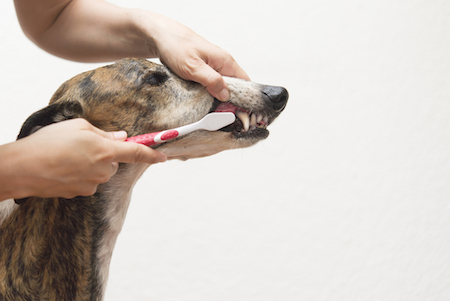
Pet insurance saves money on expensive dental care.
Pet dental health is critically important to a companion animal’s life and prevents a future, serious health risk. Daily brushing is necessary for your pet’s oral health and wellbeing. Still, it’s often a good idea to let a veterinarian give your pet a thorough dental cleaning each year.
Sometimes, some pets still develop dental health issues despite the best care given. A pet insurance plan can help cat and dog owners afford dental health prevention. Some providers include dental cleaning coverage in their add-on wellness plan riders. Insurance policies often cover serious health risks like a broken tooth, crowns, root canals, gingivitis, stomatitis, and tooth removal. All of these procedures are expensive, and a health insurance plan makes a significant difference in your out-of-pocket cost.
This February, celebrate National Pet Dental Health Month by giving your furry companion the best present possible. Get her a health insurance policy today. Start with a free quote from Pet Insurance Review, and start your furkid on the road to a clean mouth and a healthy future!
References:
- AVMA. (2022). National Pet Dental Health Month. Retrieved from https://www.avma.org/events/national-pet-dental-health-month
- Virginia Veterinary Centers. (2018). Why is Dental Care Important for Pets? Retrieved from https://virginiaveterinarycenters.com/why-dental-care-important-pets/
- Barnette, C. (2022). Dental Disease and Its Relation Systemic Disease in Pets. Retrieved from https://vcahospitals.com/know-your-pet/dental-disease-and-its-relation-to-systemic-disease-in-pets
- Gladwell, H. (2018). Why you shouldn’t brush your dog’s teeth with human toothpaste. Retrieved from https://metro.co.uk/2018/11/13/why-you-shouldnt-brush-your-dogs-teeth-with-human-toothpaste-8134211/
- Walendzinski, M. (2021). 5 Homemade Dog Toothpaste Recipes for Happy Teef. Retrieved from https://www.sidewalkdog.com/homemade-dog-toothpaste/
- The Environmental Magazine. (n.d.). 4 Things You Should Know About Dog Toothbrushes. Retrieved from https://emagazine.com/dog-toothbrush/
The information contained on this blog is intended for informational and educational purposes only and should not be construed as medical advice. It is not a substitute for professional veterinary care. Always consult with your veterinarian before making any changes to your pet's health care or treatment plan.
The authors of this blog are not veterinarians and do not claim to be experts in pet health. The information provided here is based on our own experiences and research, as well as information from reputable sources. However, we cannot guarantee the accuracy or completeness of this information.
We encourage you to do your own research and consult with your veterinarian before making any decisions about your pet's health.
Previous post
Valentine's Day Safety Tips for PetsCompare top pet insurance providers & plans.
Enter your dog’s age in years and months to calculate their age equivalent to human years.
Calculate your dog’s ageEnter your cat’s age in years and months to calculate their age equivalent to human years.
Calculate your cat’s age